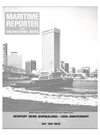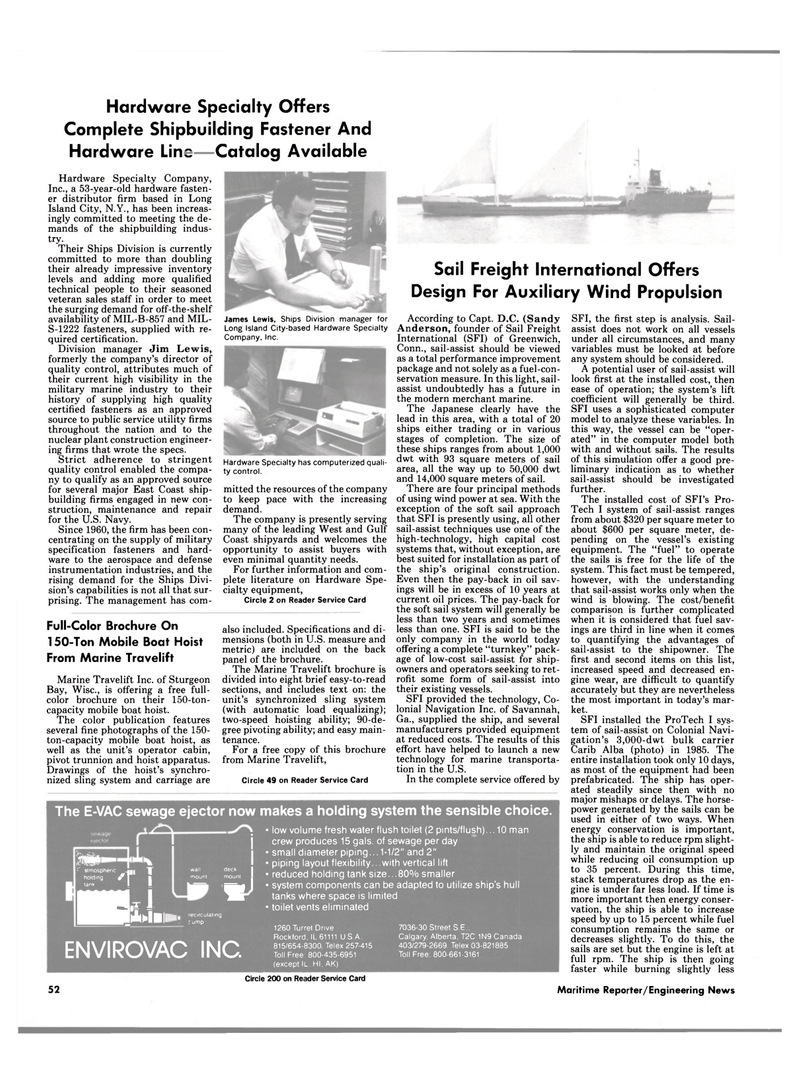
Page 50: of Maritime Reporter Magazine (May 1986)
Read this page in Pdf, Flash or Html5 edition of May 1986 Maritime Reporter Magazine
Hardware Specialty Offers
Complete Shipbuilding Fastener And
Hardware Line—Catalog Available
Hardware Specialty Company,
Inc., a 53-year-old hardware fasten- er distributor firm based in Long
Island City, N.Y., has been increas- ingly committed to meeting the de- mands of the shipbuilding indus- try.
Their Ships Division is currently committed to more than doubling their already impressive inventory levels and adding more qualified technical people to their seasoned veteran sales staff in order to meet the surging demand for off-the-shelf availability of MIL-B-857 and MIL-
S-1222 fasteners, supplied with re- quired certification.
Division manager Jim Lewis, formerly the company's director of quality control, attributes much of their current high visibility in the military marine industry to their history of supplying high quality certified fasteners as an approved source to public service utility firms throughout the nation and to the nuclear plant construction engineer- ing firms that wrote the specs.
Strict adherence to stringent quality control enabled the compa- ny to qualify as an approved source for several major East Coast ship- building firms engaged in new con- struction, maintenance and repair for the U.S. Navy.
Since 1960, the firm has been con- centrating on the supply of military specification fasteners and hard- ware to the aerospace and defense instrumentation industries, and the rising demand for the Ships Divi- sion's capabilities is not all that sur- prising. The management has corn-
Hardware Specialty has computerized quali- ty control. mitted the resources of the company to keep pace with the increasing demand.
The company is presently serving many of the leading West and Gulf
Coast shipyards and welcomes the opportunity to assist buyers with even minimal quantity needs.
For further information and com- plete literature on Hardware Spe- cialty equipment,
Circle 2 on Reader Service Card
Full-Color Brochure On 150-Ton Mobile Boat Hoist
From Marine Travelift
Marine Travelift Inc. of Sturgeon
Bay, Wise., is offering a free full- color brochure on their 150-ton- capacity mobile boat hoist.
The color publication features several fine photographs of the 150- ton-capacity mobile boat hoist, as well as the unit's operator cabin, pivot trunnion and hoist apparatus.
Drawings of the hoist's synchro- nized sling system and carriage are also included. Specifications and di- mensions (both in U.S. measure and metric) are included on the back panel of the brochure.
The Marine Travelift brochure is divided into eight brief easy-to-read sections, and includes text on: the unit's synchronized sling system (with automatic load equalizing); two-speed hoisting ability; 90-de- gree pivoting ability; and easy main- tenance.
For a free copy of this brochure from Marine Travelift,
Circle 49 on Reader Service Card
Sail Freight International Offers
Design For Auxiliary Wind Propulsion
James Lewis, Ships Division manager for
Long Island City-based Hardware Specialty
Company. Inc.
According to Capt. D.C. (Sandy
Anderson, founder of Sail Freight
International (SFI) of Greenwich,
Conn., sail-assist should be viewed as a total performance improvement package and not solely as a fuel-con- servation measure. In this light, sail- assist undoubtedly has a future in the modern merchant marine.
The Japanese clearly have the lead in this area, with a total of 20 ships either trading or in various stages of completion. The size of these ships ranges from about 1,000 dwt with 93 square meters of sail area, all the way up to 50,000 dwt and 14,000 square meters of sail.
There are four principal methods of using wind power at sea. With the exception of the soft sail approach that SFI is presently using, all other sail-assist techniques use one of the high-technology, high capital cost systems that, without exception, are best suited for installation as part of the ship's original construction.
Even then the pay-back in oil sav- ings will be in excess of 10 years at current oil prices. The pay-back for the soft sail system will generally be less than two years and sometimes less than one. SFI is said to be the only company in the world today offering a complete "turnkey" pack- age of low-cost sail-assist for ship- owners and operators seeking to ret- rofit some form of sail-assist into their existing vessels.
SFI provided the technology, Co- lonial Navigation Inc. of Savannah,
Ga., supplied the ship, and several manufacturers provided equipment at reduced costs. The results of this effort have helped to launch a new technology for marine transporta- tion in the U.S.
In the complete service offered by
The E-VAC sewage ejector now makes a holding system the sensible choice.
J atmospheric _ n "J" holding £ | tank I •L. wall deck mount mount • low volume fresh water flush toilet (2 pints/flush)... 10 man j crew produces 15 gals, of sewage per day • small diameter piping... 1-1/2" and 2" • piping layout flexibility...with vertical lift
I • reduced holding tank size...80% smaller ^^ J • system components can be adapted to utilize ship's hull ^Br tanks where space is limited • toilet vents eliminated recirculating rump
ENVIROVAC INC 1260 Turret Drive
Rockford. IL 61111 U S A 815/654-8300. Telex 257-415
Toll Free: 800-435-6951 (except IL. HI. AK) 7036-30 Street S.E.,
Calgary. Alberta. T2C 1N9 Canada 403/279-2669. Telex 03-821885
Toll Free: 800-661-3161
Circle 200 on Reader Service Card 52
SFI, the first step is analysis. Sail- assist does not work on all vessels under all circumstances, and many variables must be looked at before any system should be considered.
A potential user of sail-assist will look first at the installed cost, then ease of operation; the system's lift coefficient will generally be third.
SFI uses a sophisticated computer model to analyze these variables. In this way, the vessel can be "oper- ated" in the computer model both with and without sails. The results of this simulation offer a good pre- liminary indication as to whether sail-assist should be investigated further.
The installed cost of SFI's Pro-
Tech I system of sail-assist ranges from about $320 per square meter to about $600 per square meter, de- pending on the vessel's existing equipment. The "fuel" to operate the sails is free for the life of the system. This fact must be tempered, however, with the understanding that sail-assist works only when the wind is blowing. The cost/benefit comparison is further complicated when it is considered that fuel sav- ings are third in line when it comes to quantifying the advantages of sail-assist to the shipowner. The first and second items on this list, increased speed and decreased en- gine wear, are difficult to quantify accurately but they are nevertheless the most important in today's mar- ket.
SFI installed the ProTech I sys- tem of sail-assist on Colonial Navi- gation's 3,000-dwt bulk carrier
Carib Alba (photo) in 1985. The entire installation took only 10 days, as most of the equipment had been prefabricated. The ship has oper- ated steadily since then with no major mishaps or delays. The horse- power generated by the sails can be used in either of two ways. When energy conservation is important, the ship is able to reduce rpm slight- ly and maintain the original speed while reducing oil consumption up to 35 percent. During this time, stack temperatures drop as the en- gine is under far less load. If time is more important then energy conser- vation, the ship is able to increase speed by up to 15 percent while fuel consumption remains the same or decreases slightly. To do this, the sails are set but the engine is left at full rpm. The ship is then going faster while burning slightly less
Maritime Reporter/Engineering News

 49
49

 51
51
